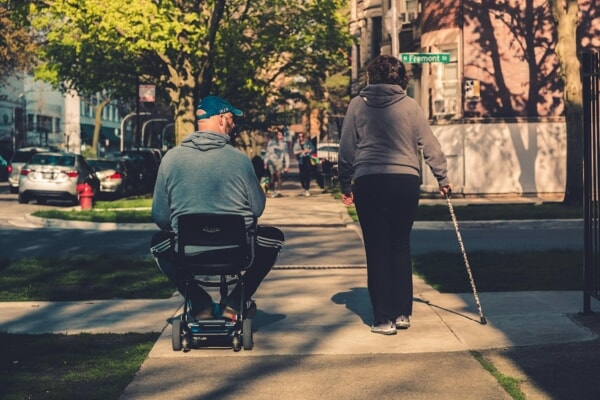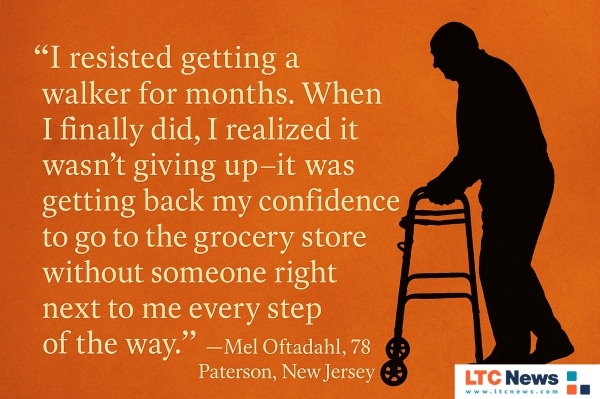From Canes to Power Chairs: How to Choose the Right Mobility Aid for Older Family Members

You’ve seen your mom or dad hesitate before getting up. Maybe they grip the table before standing or pause at the top of the stairs, scanning for something to hold. That moment—the hesitation—is often the first sign that mobility is changing. It’s not just about moving from one room to another. It’s about safety, confidence, and independence.
That’s where mobility aids can make all the difference. Whether you’re a caregiver, a family member, or thinking about your own future needs, knowing your options now can help you make decisions that protect both safety and quality of life.
What Seniors Are Using—and Why it Matters
Before you choose a mobility aid for your parent—or yourself—it helps to understand what older adults are already using and why. Trends in mobility device use aren’t just numbers on a chart; they reveal how people adapt to changes in strength, balance, and health over time. They also highlight when a cane is enough, when a walker makes sense, and when it’s time to consider something more supportive.
Seeing the bigger picture can guide you toward a choice that works now and still makes sense for the years ahead.
- Over 16 million U.S. adults use mobility devices, ranging from walkers to power wheelchairs.
- Among people 65 and older: about 10 percent use canes, 4.6 percent use walkers, and 3 percent use wheelchairs or scooters.
- The most common setups are:
- Cane only (44.3%)
- Cane + walker (15.7%)
- Walker only (15.1%)
- Walker + wheelchair (8.3%)
This suggests that most people begin with light support and may progress to more substantial devices over time.
Mobility assistive devices are necessities for persons with mobility limitations who need the functions of these devices to engage in activities at home and in the community. The primary mobility devices are wheelchairs and scooters, often with such necessary accessories as custom cushions, reclining functions, wheelchair casters, power assists, and seat elevation. Beyond their transport function, mobility devices are important to many users because they enable independence and autonomy. — Disability Rights Education and Defense Fund (DREDF) report.
Types of Mobility Devices: What Works—and When
Choosing a mobility device isn’t a one-size-fits-all decision. The right option depends on the level of support needed, physical strength, living environment, and lifestyle. Here’s a clear look at what’s available and when it makes sense.
1. Walking Aids: Stability You Can Hold Onto
If balance is the main concern, walking aids are often the first step. They provide extra stability without a big change to a person’s daily routine.
- Canes: Light, affordable, and best for mild balance issues.
- Quad canes: Four feet on the base for added stability.
- Crutches & forearm crutches: Transfer weight off an injured or weak leg, but require upper-body strength.
2. Walkers and Rollators: For When You Need More
When stability is a daily concern or fatigue sets in quickly, walkers provide a safer, more supportive option.
- Standard walkers: Sturdy frames you lift step by step.
- Walker-cane hybrids: Offer more support than a cane, less bulk than a walker.
- Rollators: Wheels, brakes, a seat, and a basket—ideal for those who want to move freely and rest when needed.
3. Wheelchairs: From Manual to Smart Standing Options
When walking isn’t possible or practical, wheelchairs allow independence without overexertion.
- Manual wheelchairs: Self-propel or pushed by a caregiver, a good option for short - or medium-term use - think recovering from an injury or surgery.
- Power wheelchairs: Battery-powered, controlled with a joystick.
- Standing wheelchairs: Raise the user to a standing position while providing mobility.
- Smart wheelchairs: Equipped with navigation aids for users with cognitive or motor challenges.
4. Mobility Scooters: Comfortable, Battery-Powered Freedom
Scooters bridge the gap for those who can walk short distances but need help for longer outings.
- Three-wheel scooters: Easy to maneuver in tight spaces.
- Four-wheel scooters: More stable for outdoor and uneven terrain.
5. Other Support: Stand, Transfer, and Gait Aids
Mobility is more than walking—sometimes it’s about safely standing, shifting, or transferring.
- Knee scooters: Rest one leg, propel with the other.
- Transfer boards & patient lifts: Essential for safe moves between seating or beds.
- Gait trainers: Supportive walkers for rehabilitation and strength building.
What to Consider When Choosing a Device
Before you buy, think about more than just the current need. A poorly chosen device can create frustration, cause injuries, or limit independence.
- Strength & endurance: Can they walk short distances or not at all?
- Daily life: Mostly indoors, outdoors, or traveling?
- Home setup: Door widths, stairs, flooring.
- Budget & coverage: Insurance may offset costs for some devices.
- Comfort & ergonomics: Proper fit prevents strain and injury.
Consulting an occupational or physical therapist is one of the best ways to ensure the device matches current and future needs.
How Insurance Pays for Mobility Devices
Paying for a mobility aid can be a shock if you don’t understand how coverage works—and what’s excluded. Coverage varies by Medicare, Medicaid, private health insurance, Long-Term Care Insurance, and veterans’ benefits.
Medicare
- Part B may cover durable medical equipment (DME) like walkers, manual wheelchairs, and even a power wheelchair for adults — but only if prescribed by a doctor and used in your home.
- You typically pay 20% of the Medicare-approved amount after meeting your deductible.
- Power wheelchairs and scooters require additional documentation proving you cannot use a manual wheelchair and need powered mobility indoors.
Medicaid
- State programs often cover a wider range of devices, including advanced power chairs, if deemed medically necessary.
- Coverage, paperwork, and approved suppliers vary by state.
Private Health Insurance
- Plans differ, but many cover at least part of the cost for prescribed DME.
- You may have to use in-network providers, and pre-authorization is often required.
Long-Term Care Insurance
- Some LTC Insurance policies offer cash benefits, either in full or in part, which could be used for mobility devices.
- Policies that include an alternate plan of care could also cover the costs for mobility devices, especially if having the device allows the policyholder to remain at home, avoiding a long-term care facility.
Veterans Benefits (VA)
- Eligible veterans can receive mobility devices at no cost through VA health services, often with access to higher-end or custom models.
When Insurance Doesn’t Pay
- Most plans do not cover devices purchased for convenience, outdoor recreation, or as a backup.
- Comfort upgrades—like custom upholstery, cup holders, or specialty paint—are usually out-of-pocket.
- Replacement timelines apply—often one device every five years unless damage or medical needs change.
Tip: Always confirm coverage before ordering. Buying without approval can mean paying the full amount yourself.
Real People, Real Challenges—and Real Progress
Mobility devices aren’t perfect. A recent study found that many older adults view walkers as bulky, noisy, or even unsafe on uneven ground. Some avoid using them altogether because of the perceived stigma or frustration with handling them.

Share your thoughts and experiences about aging, caregiving, health, and long-term care with LTC News —Contact LTC News.
Innovations are on the horizon. Manufacturers are testing lightweight carbon-fiber walkers, quiet-roll wheels, and AI-enabled power chairs that automatically adjust speed and turning radius based on the environment. Ergonomic handles and foldable designs are making it easier for caregivers to transport devices in smaller cars.
The lesson is clear: while no device is perfect, user-centered design is improving both safety and dignity for older adults. The best device is one that people will actually use—and use comfortably.
Your Next Steps
- Start with what your parent can manage today and upgrade as needs change.
- Ask them directly: Where do you wish you felt steadier?
- Test devices in person before purchasing.
- Look into insurance coverage and local funding programs.
Final Thought: Mobility and Planning for the Years Ahead
Mobility aids are more than tools—they’re a way to maintain independence, dignity, and connection. But they also serve as an early signal that long-term care planning should be part of your retirement strategy.
Loss of mobility often increases the need for in-home caregivers, home modifications, or even assisted living or skilled nursing care. Medicare and standard health insurance typically do not cover extended personal care beyond short rehabilitation stays.
That’s why financial planning—including Long-Term Care Insurance—is essential. Policies can help cover the cost of professional caregivers, home health services, or facility care, ensuring you or your loved one can afford the right help without depleting savings. Most people acquire an LTC policy between the ages of 47 and 67, although you can find affordable options at all ages, depending on your health.
You can use the LTC News Cost of Care Calculator to see what care costs in your area today and what they may look like in 10 or 20 years. Planning now means you’re ready when needs arise—without having to scramble in a crisis.
If you are looking for extended care for a loved one, use the LTC News Caregiver Directory to search from over 80,000 providers nationwide.
When you choose a mobility device, you’re not just making a purchase for today. You’re laying the groundwork for safety, independence, and the quality of life you’ll want to protect in the years to come.


